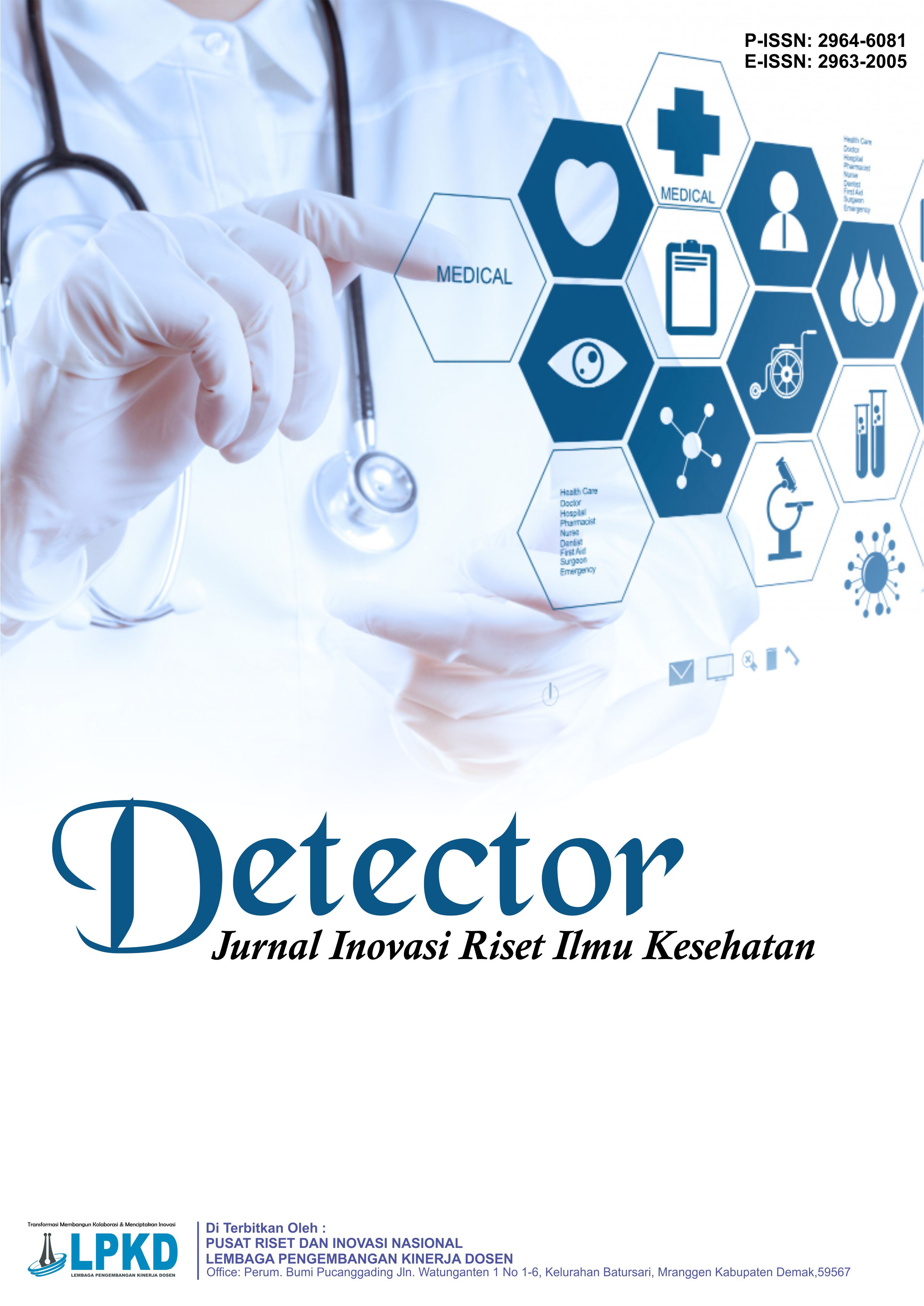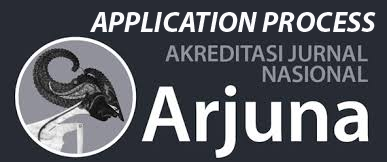Analisis Faktor-Faktor yang Mempengaruhi Kejadian Kista Ovarium pada Wanita Usia Subur di Puskesmas Tlogosari Kulon Semarang
DOI:
https://doi.org/10.55606/detector.v3i2.4919Keywords:
Factors, Ovarian Cysts, WUSAbstract
Ovarian cysts are a type of reproductive disease that often attacks women. Ovarian cysts are collections of fluid in the ovaries or fallopian tubes that accumulate and are surrounded by a membrane formed from the outer layer of the ovaries. Many people, especially women of childbearing age, do not know the factors that cause ovarian cysts themselves. Cyst Factor Analysis aims to increase public knowledge for early prevention. This research is a type of quantitative research using a cross sectional approach. The sample used was 109 respondents and anticipated drop out was 121 respondents in the work area of the Tlogosari Kulon Semarang Health Center. The sample was taken using a probability sampling technique with a simple random sampling type. The comparative test used was the Chi-Square test. The results of research using the Chi-Square test proved that the p value of the ovarian cyst factors was <0.05. This shows that there is a significant and strengthening relationship between age, menstrual cycle, genetic history, parity, economic status, history of previous cysts, menarche, hypothyroidism. There is a relationship between age, menstrual cycle, genetic history, parity, economic status, history of previous cysts, menarche, hypothyroidism on the incidence of ovarian cysts in women of childbearing age at the Tlogosari Kulon Semarang Community Health Center, and factors that have a significant influence are genetic history with a p-value <0.050.
Downloads
References
Alexander, C. D., & Kuller, J. A. (2020). Fetal ovarian cyst. Journal of Diagnostic Medical Sonography, 20(6), 431–435. https://doi.org/10.1177/8756479304269946
Cibula, D., Widschwendter, M., Májek, O., & Dusek, L. (2020). Tubal ligation and the risk of ovarian cancer: Review and meta-analysis. Human Reproduction Update, 17(1), 55–67. https://doi.org/10.1093/humupd/dmq030
Cramer, D. W., Welch, W. R., Ryan, K. J., Hutchison, G. B., & Scully, R. E. (2020). Determinants of Ovarian Cancer Risk. I. Reproductive Experiences and Family History. Journal of the National Cancer Institute, 71(4), 703–709. https://doi.org/10.1093/jnci/71.4.711
Fadhilah, MZ, O., & DAH, P. (2021). Profil Tumor Ovarium Di Rsi Siti Rahmah Padang Tahun 2017-2018. Jurnal Kesehatan Saintika Meditory, 4(2), 130. https://doi.org/10.30633/jsm.v4i2.1316
Fatkhiyah, N. (2020). fAKTOR KEJADIAN KISTA OVARIUMPADA WANITA USIA REPRODUKSI.
Gaitskell, K., Green, J., Pirie, K., & Reeves, G. (2021). Tubal ligation and ovarian cancer risk in a large cohort: Substantial variation by histological type. International Journal of Cancer, 138(5), 1076–1084. https://doi.org/10.1002/ijc.29856
Haeruddin. (2023). Hubungan Siklus Menstruasi Dengan Kejadian Dismenore. Journal Homepage, 2, 6–20.
Heddy, Jamilah, N., & Zulhijjah, A. (2023). Faktor – Faktor Yang Berhubungan Dengan Kejadian Kista Ovarium Pada Wanita Usia Subur Di Poli Bkia Rumah Sakit Kencana Kota Serang. Jurnal Ilmiah Obsgin, 15(1), 354–363.
Herman, S., Studi, P., Mesin, T., Mesin, J. T., Teknik, F., Sriwijaya, U., Saputra, R. A., IRLANE MAIA DE OLIVEIRA, Rahmat, A. Y., Syahbanu, I., Rudiyansyah, R., Sri Aprilia and Nasrul Arahman, Aprilia, S., Rosnelly, C. M., Ramadhani, S., Novarina, L., Arahman, N., Aprilia, S., Maimun, T., … Jihannisa, R. (2019). kista ovarium. Jurusan Teknik Kimia USU, 3(1), 18–23.
Kau, M., Adam, D., Djafar, L., Borolla, H., & Dengo, M. R. (2023). Determinan Kejadian Kista Ovarium Pada Wanita Usia Subur Di Rsia Sitti Khadidjah Gorontalo. Jambura Journal of Health Sciences and Research, 5(3), 834–842. https://doi.org/10.35971/jjhsr.v5i3.20109
Keith A. Hansen, M.D. (2020).
Lestari, M., & Amal, F. (2022). Faktor-Faktor Yang Berhubungan Dengan Siklus Haid Tidak Teratur Pada Mahasiswi Kebidanan Poltekkes Kemenkes Jayapura. Jurnal Sehat Mandiri, 14(2), 57–63. https://doi.org/10.33761/jsm.v14i2.107
Livana, P., Resa Hadi, S., Terri, F., Dani, K., & Firman, A. (2020). Implementasi Mobilisasi Dini Untuk Meningkatkan Peristaltik Usus Pasien Post Laparatomi Atas Indikasi Kista Ovarium. Indonesian Journal of Nursing and Health Sciences, 1(1), 37–48.
Manulu. (2023). SENTRI : Jurnal Riset Ilmiah. SENTRI: Jurnal Riset Ilmiah, 2(4), 1275--1289.
Medicine ; Mohammad Eid, W. F. M. E. J. O. F., & Mahfouz, M. (2021). Risk factors for hypothyroidism in Saudi Arabia. World Family Medicine, 19(1), 215–224. https://doi.org/10.5742/MEWFM.2021.93972
mobeen,sadia ; Apostol, R. (n.d.). kista ovarium. National Library of Medicine. https://www.ncbi.nlm.nih.gov/books/NBK560541/
Nosakaytu, G. I., Jayadi, T., Putra, E., & Kusumosih, T. (2022). Hubungan Usia Dengan Jenis Tumor Ovarium Di Rumah Sakit Bethesda Yogyakarta Tahun 2019. Prominentia Medical Journal, 3(2), 1–8. https://doi.org/10.37715/pmj.v3i2.3066
Puluhulawa, I. (2020). Pengaruh Faktor Sosial Ekonomi Terhadap Status. E-Jurnal Katalogis, 1(3), 15–25. https://media.neliti.com/media/publications/152348-ID-pengaruh-faktor-sosial-ekonomi-terhadap.pdf
Puspita, A., Munir, M. A., Faris, A., Program, M. P., & Infection, D. (2021). Case report : treatment of ovarian cysts with total hysterectomy and bilateral salfingooferectomy. Jurnal Profesi Medis, 3(2), 149–153.
Revzin, M. V., Moshiri, M., Katz, D. S., Pellerito, J. S., Gettle, L. M., & Menias, C. O. (2020). Imaging evaluation of fallopian tubes and related disease: A primer for radiologists. Radiographics, 40(5), 1473–1501. https://doi.org/10.1148/rg.2020200051
Risna Suma, M., & Nopita Sari, N. M. (2019). Penerapan Penerapan Self Hypnosis Pada Ny “SW” Umur 40 Tahun dengan Kista Ovarium (Penatalaksanaan pada Gangguan Reproduksi dengan Kista Ovarium di Ruang Dara RSUD Wangaya). Journal Center of Research Publication in Midwifery and Nursing, 1(2), 1–7. https://doi.org/10.36474/caring.v1i2.1
Sulistiyah, S., & Keswara, N. W. (2023). Faktor Penunjang Terjadinya Kista Ovarium di Klinik Daun Sendok Kabupaten Pasuruan. Proceedings Series on Health & Medical Sciences, 4, 31–36. https://doi.org/10.30595/pshms.v4i.550
Suryoadji, K. A., Fauzi, A., Ridwan, A. S., & Kusuma, F. (2022). Diagnosis dan Tatalaksana pada Kista Ovarium: Literature Review. Khazanah: Jurnal Mahasiswa, 14(1), 38–48. https://doi.org/10.20885/khazanah.vol14.iss1.art5
Ulfah, Ria, Iswandari, U., Dewi, N., & Anisa, F. N. (2023). Analisis Kejadian Kista Ovarium pada Pasangan Usia Subur di Rumah Sakit Umum Daerah Muara Teweh Tahun 2021. Health Research Journal of Indonesia, 2(1), 87–93. https://doi.org/10.63004/hrji.v2i1.289
Walyuni, N., M, A., & Hadriyanti Hamang, S. (2021). Manajemen Asuhan Kebidanan Gangguan Sistem Reproduksi pada Ny. S dengan Kista Ovarium. Window of Midwifery Journal, 2(2), 65–76. https://doi.org/10.33096/wom.vi.246
Wenas, G. E., Opod, H., & Pali, C. (2020). Hubungan Kebahagiaan Dan Status Sosial Ekonomi. E-Biomedik (EBm), 3(April), 1–7.
Widyarni, A. (2020). Faktor Resiko Kejadian Kista Ovarium Di Poliklinik Kandungan dan Kebidanan Rumah Sakit Islam Banjarmasin. Dinamika Kesehatan: Jurnal Kebidanan Dan Keperawatan, 11(1), 28–36. https://doi.org/10.33859/dksm.v11i1.569
Downloads
Published
How to Cite
Issue
Section
License
Copyright (c) 2025 Detector: Jurnal Inovasi Riset Ilmu Kesehatan

This work is licensed under a Creative Commons Attribution-ShareAlike 4.0 International License.








